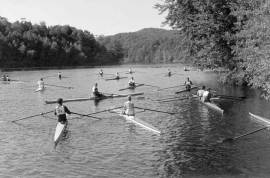
Green Mountain Head Regatta
- Oct 3, 2021
- head
- Connecticut River
- Putney, VT (USA)
- Hosted By: Putney Rowing Club
- Cancelled
History of the Green Mountain Club
The first Green Mountain Head Regatta was held some time in the nineteenth century. The boats were crafted using a crude and solid design during the winter months and dragged to the river between the towns of Pittsburgh and Colebrook, New Hampshire where they awaited the first snowmelt, which was the official start of the race. Rowers wore hobnail boots and carried iron tipped staffs instead of sculls. Logjams were common, especially near Bellows Falls, and the race was often re-started using dynamite. More recently, the boats have been hollowed out and the racers use a staggered start to avoid jamming. The logjams have been moved to Montpelier and Concord.
In 1981, the modern Green Mountain Head was the brainchild of President-For-Life Peter Heller and his brother George. Living in exile on Nantucket, the would-be emperor Peter created the Shimmo Rowing Club, named after the beach where he waded-in his shell every morning. 'What good is a rowing club without a regatta?' thought Peter, and furthermore, 'What good is a regatta without a river?' So, he called brother George and asked if he might borrow his river, the Connecticut. George agreed, and called his friends at the Cambridge Boat Club. Jerry Olrich agreed to race, and brought sixty of his closest friends with him. John Caldwell provided the awards by tapping a few trees, boiling some syrup, and picking a few apples, a tradition which lives to this day.
As the real estate agents say, 'Location, location, location' are the three most important ingredients in many ventures, and the Green Mountain Head owes much of its charm and format to the Putney, Vermont venue. The river here is wide and protected by a deep valley between the hills of Vermont and New Hampshire, an ideal site for rowing. However, there are very few places to launch and land boats, so the start and finish must be at the same place and a stake race format is used. Additionally, George and Peter were both big fans of Thomas Eakins, and they like the whole 'rounding the stake' idea. Since large rowing shells turn stakes with all the grace of a Holstein at a contra dance, the regatta is limited to single and double sculls. A large cornfield at the start/finish area provides ample room to park, rig, and picnic. Racers enjoy the post-race luncheon of traditional Vermont foods such as cheddar cheese, fresh bread, apple cider, doughnuts, and egg rolls.
The regatta is large by sculling standards, but retains its small town charm. Over the last two decades, the race has grown from 65 participants to 350. Racers range in age from 10 to their mid-80 years. The longstanding double of John Caldwell and George Heller boasted a combined age over 150 years. The regatta attracts many elite scullers preparing for the other major head race on the Charles. Gevvie Stone, Xeno Muller, Jamie Koven, and John Riley have all won the race, and the results sheet looks like a who's-who of present and former national team members. Many families enjoy the outing, including the Dreissigackers, the Geer sisters, the Laundons, Cromwells, and Hamlins.
Putney has been the home of Graeme King's boatworks, and many of his creations come home to roost for the weekend. For those rowers who do not share the good fortune of rowing a wooden boat, plastic shells are acceptable. The regatta is always held three weeks before the Head of the Charles. Please join us.
